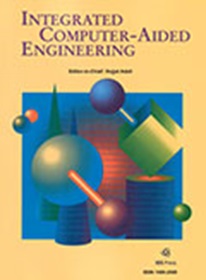基于物联网实时手势控制系统的工业4.0人机交互
IF 5.3
2区 计算机科学
Q1 COMPUTER SCIENCE, ARTIFICIAL INTELLIGENCE
引用次数: 12
摘要
在工业环境快速数字化的背景下,工业4.0旨在改善关键要素,以实现更高效的流程、定制产品的灵活性和降低能耗等目标。本文提出了一个利用物联网(IoT)、海量数据计算和人机协作来实现这些目标的系统。所描述的系统结合了技术和以人为中心的方面来增强人机交互。事实上,当技术进步对社会产生影响时,人的因素是不能被撇开的。该提案已在手势控制系统上进行了测试,该系统通过使用面向物联网的惯性测量单元设备,实现了与机械臂的自然交互。这些设备可以捕捉人类双臂的运动。已经进行了技术性质的实验来测量准确性和延迟。此外,还对真实用户进行了以人为中心的测试,以确定所提议的手势控制的直观性和接受程度。结果表明,该方案在实时性、成功率、灵活性和可扩展性等方面满足工业4.0的基本要求。可用性结果使我们能够对这种人机交互系统的使用得出有用的结论。本文章由计算机程序翻译,如有差异,请以英文原文为准。
Human-robot interaction in Industry 4.0 based on an Internet of Things real-time gesture control system
In the context of fast-growing digitization of industrial environments, Industry 4.0 aims to improve key elements to achieve more efficient processes, flexibility in customizing products and reduction in energy consumption, among other objectives. This paper presents a system that exploits the Internet of Things (IoT), massive data computation, and human-robot collaboration to reach these goals. The described system combines technological and human-centered aspects to enhance human-robot interaction. In fact, the human factor cannot be left aside when technological advances affecting society are foreseen. The proposal has been tested on a gesture control system that enables a natural interaction with a robotic arm through the use of IoT-oriented inertial measurement unit devices. These devices capture the movements of both human’s arms. Experiments of a technical nature have been run to measure accuracy and latency. In addition, human-centered tests have been conducted with real users to determine the level of intuitiveness and acceptance of the proposed gesture control. The results obtained demonstrate that the proposal meets the demands in terms of real-time, success rate, flexibility and scalability, which are fundamental requirements in Industry 4.0. The usability results have enabled drawing useful conclusions on the use of such human-robot interaction systems.
求助全文
通过发布文献求助,成功后即可免费获取论文全文。
去求助
来源期刊

Integrated Computer-Aided Engineering
工程技术-工程:综合
CiteScore
9.90
自引率
21.50%
发文量
21
审稿时长
>12 weeks
期刊介绍:
Integrated Computer-Aided Engineering (ICAE) was founded in 1993. "Based on the premise that interdisciplinary thinking and synergistic collaboration of disciplines can solve complex problems, open new frontiers, and lead to true innovations and breakthroughs, the cornerstone of industrial competitiveness and advancement of the society" as noted in the inaugural issue of the journal.
The focus of ICAE is the integration of leading edge and emerging computer and information technologies for innovative solution of engineering problems. The journal fosters interdisciplinary research and presents a unique forum for innovative computer-aided engineering. It also publishes novel industrial applications of CAE, thus helping to bring new computational paradigms from research labs and classrooms to reality. Areas covered by the journal include (but are not limited to) artificial intelligence, advanced signal processing, biologically inspired computing, cognitive modeling, concurrent engineering, database management, distributed computing, evolutionary computing, fuzzy logic, genetic algorithms, geometric modeling, intelligent and adaptive systems, internet-based technologies, knowledge discovery and engineering, machine learning, mechatronics, mobile computing, multimedia technologies, networking, neural network computing, object-oriented systems, optimization and search, parallel processing, robotics virtual reality, and visualization techniques.
 求助内容:
求助内容: 应助结果提醒方式:
应助结果提醒方式:


